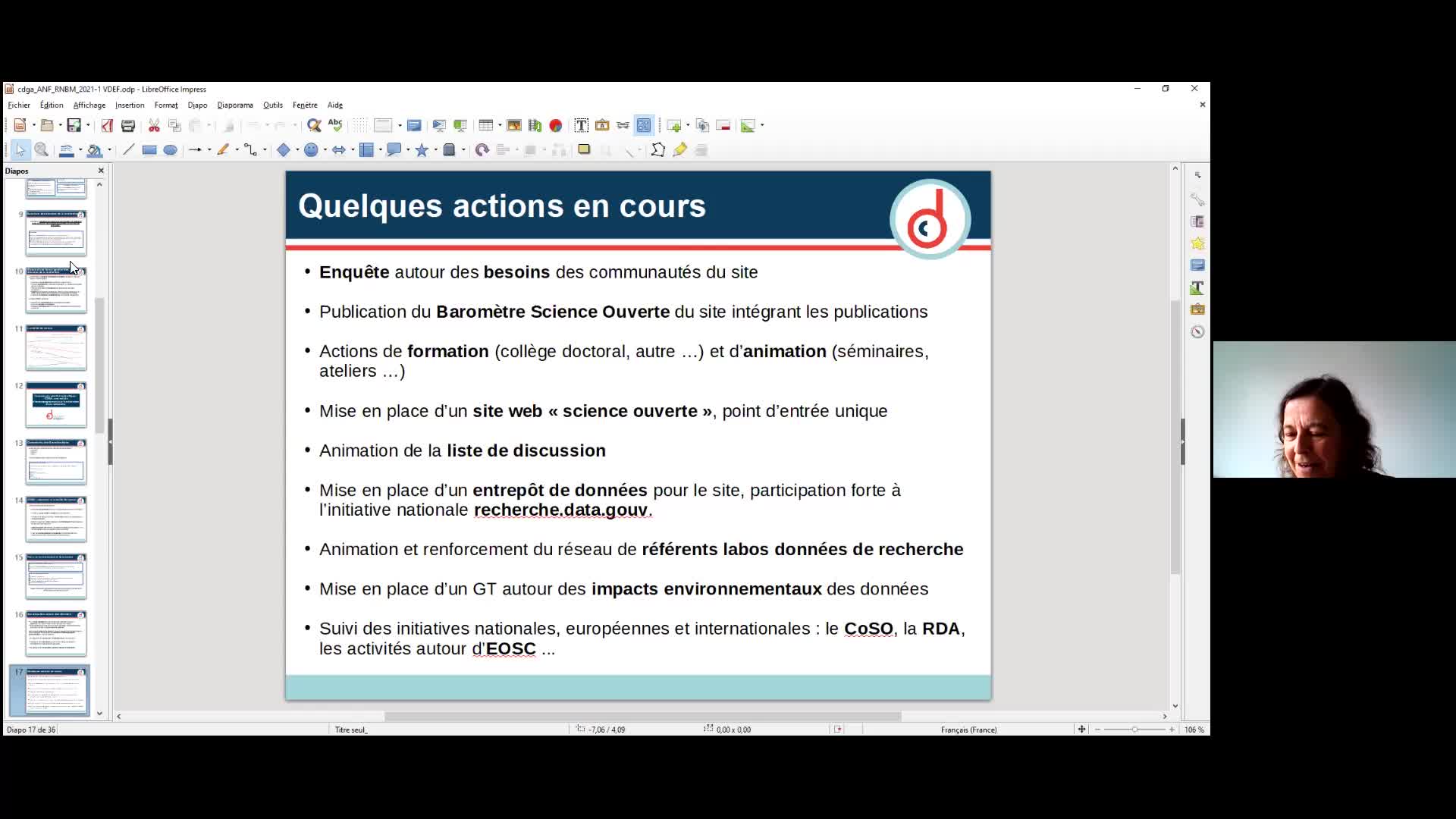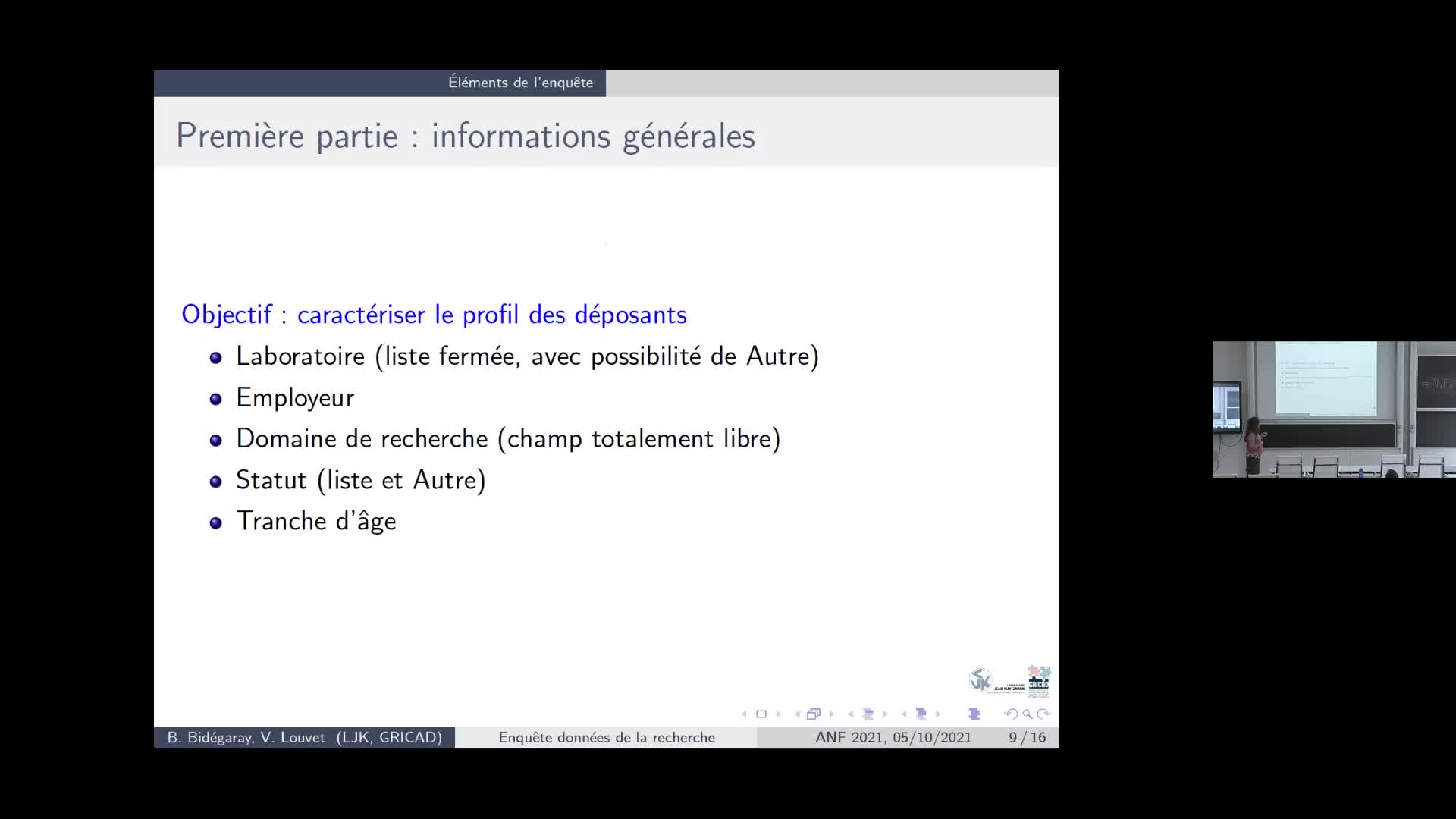Notice
Webinaire sur la rédaction des PGD
- document 1 document 2 document 3
- niveau 1 niveau 2 niveau 3
Descriptif
Le groupe de travail inter-réseau Mathrice-RNBM sur les données de la recherche a proposé un webinaire sur la rédaction des Plans de Gestion de Données (PGD) sous l’angle des besoins de la communauté mathématique.
La plupart des porteurs de projets financés sont désormais confrontés à la rédaction d’un PGD. Or ce document n’est pas toujours bien compris et sa finalité bien appréhendée. L’objectif de ce webinaire était de présenter les PGD sous l’angle des besoins de la communauté mathématique et d’apporter les réponses aux questions, telles que :
- En tant que chercheur / chercheuse en Maths, pourquoi ai-je intérêt à rédiger un PGD?
- Parmi les outils existants lequel utiliser ? Et quel type de modèle ?
- A qui m’adresser localement pour un accompagnement ciblé ?
Thème
Documentation
Avec les mêmes intervenants et intervenantes
-
Retour d'expérience : Cellule multi-compétences
AlbaretLucieLouvetViolaineRetour d'expérience : Cellule multi-compétences, Lucie Albaret, Violaine louvet
-
Présentation de l’enquête sur les données mathématiques
Bidégaray-FesquetBrigitteLouvetViolainePrésentation de l’enquête sur les données mathématiques.
Sur le même thème
-
Tuan Ta Pesao : écritures de sable et de ficelle à l'Ile d'Ambrym
VandendriesscheEricCe film se déroule au Nord de l’île d’Ambrym, dans l’archipel de Vanuatu, en Mélanésie...
-
"Le mathématicien Petre (Pierre) Sergescu, historien des sciences, personnalité du XXe siècle"
HerléaAlexandreAlexandre HERLEA est membre de la section « Sciences, histoire des sciences et des techniques et archéologie industrielle » du CTHS. Professeur émérite des universités, membre effectif de l'Académie
-
Alexandre Booms : « Usage de matériel pédagogique adapté en géométrie : une transposition à interro…
« Usage de matériel pédagogique adapté en géométrie : une transposition à interroger ». Alexandre Booms, doctorant (Université de Reims Champagne-Ardenne - Cérep UR 4692)
-
J. Wang - Topological rigidity and positive scalar curvature
WangJianIn this talk, we shall describe some topological rigidity and its relationship with positive scalar curvature. Precisely, we will present a proof that a complete contractible 3-manifold with
-
T. Ozuch - Noncollapsed degeneration and desingularization of Einstein 4-manifolds
OzuchTristanWe study the noncollapsed singularity formation of Einstein 4-manifolds. We prove that any smooth Einstein 4-manifold close to a singular one in a mere Gromov-Hausdorff (GH) sense is the result
-
D. Tewodrose - Limits of Riemannian manifolds satisfying a uniform Kato condition
TewodroseDavidPresentation of a joint work with G. Carron and I. Mondello where we study Kato limit spaces.
-
A. Mondino - Time-like Ricci curvature bounds via optimal transport
MondinoAndreaThe goal of the talk is to present a recent work in collaboration with Cavalletti (SISSA) on optimal transport in Lorentzian synthetic spaces. The aim is to set up a “Lorentzian analog” of the
-
M. Lesourd - Positive Scalar Curvature on Noncompact Manifolds and the Positive Mass Theorem
LesourdMartinThe study of positive scalar curvature on noncompact manifolds has seen significant progress in the last few years. A major role has been played by Gromov's results and conjectures, and in
-
P. Burkhardt - Pointwise lower scalar curvature bounds for C0 metrics via regularizing Ricci flow
Burkhardt-GuimPaulaWe propose a class of local definitions of weak lower scalar curvature bounds that is well defined for C0 metrics. We show the following: that our definitions are stable under greater-than-second
-
R. Perales - Recent Intrinsic Flat Convergence Theorems
PeralesRaquelThéorèmes récents de convergence plane intrinsèque
-
J. Fine - Knots, minimal surfaces and J-holomorphic curves
FineJoëlI will describe work in progress, parts of which are joint with Marcelo Alves. Let L be a knot or link in the 3-sphere. I will explain how one can count minimal surfaces in hyperbolic 4-space
-
D. Semola - Boundary regularity and stability under lower Ricci bounds
SemolaDanieleThe theory of non smooth spaces with lower Ricci Curvature bounds has undergone huge developments in the last thirty years. On the one hand the impetus came from Gromov’s precompactness theorem














